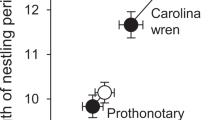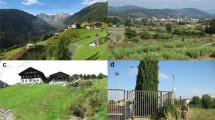Summary
Nest humidity (\(P_{{\text{H}}_2 {\text{O}}} \)) under an incubating bantam hen was measured at ambient\(P_{{\text{H}}_2 {\text{O}}} \) ranging from 1.3 to 25.0 mmHg. Weight loss of eggs was recorded in clutches of varying size. Nest\(P_{{\text{H}}_2 {\text{O}}} \) and ambient\(P_{{\text{H}}_2 {\text{O}}} \) were also measured in wild incubating willow ptarmigan nests in dry and wet habitats.
Nest\(P_{{\text{H}}_2 {\text{O}}} \) increased linearly with ambient\(P_{{\text{H}}_2 {\text{O}}} \) in a way predictable on the assumption that the water vapour conductance (\(G_{{\text{H}}_2 {\text{O}}} \)) of brood patch skin, plumage and eggs were constant and independent of ambient\(P_{{\text{H}}_2 {\text{O}}} \). Nest\(P_{{\text{H}}_2 {\text{O}}} \) was also dependent of clutch size. Egg dehydration was quantitatively predicted from measured values and the laws of diffusion.
Our findings confirm earlier conclusions that the adult bird does not actively regulate nest\(P_{{\text{H}}_2 {\text{O}}} \) at varying ambient\(P_{{\text{H}}_2 {\text{O}}} \). Birds can presumably achieve appropriate egg dehydration by a strategy combining nest site, nest construction, egg shell conductance and incubation behaviour which meets the requirements of their breeding climate.
Similar content being viewed by others

Abbreviations
- \(P_{{\text{H}}_2 {\text{O}}} \) :
-
water vapur pressure
- \(G_{{\text{H}}_2 {\text{O}}} \) :
-
water vapur conductance
- \(\dot M_{{\text{H}}_2 {\text{O}}} \) :
-
water flux
References
Ar A, Rahn H (1980) Water in the avian egg: Overall budget of incubation. Am Zool 20:373–384
Birchard GF, Kilgore jr DL (1980) Conductance of water vapor in eggs of burrowing and nonburrowing birds: Implications for embryonic gas exchange. Physiol Zool 53:284–292
Carey C (1980) Adaptation of the avian egg to high altitude. Am Zool 20:449–459
Chattock AP (1925) On the physics of incubation. Philos Trans R Soc Ser B 213:397–450
Davis TA, Platter-Reiger MF, Ackerman RA (1984) Incubation water loss by pied-billed grebe eggs: Adaptation to a hot, wet nest. Physiol Zool 57:384–391
Drent RH (1970) Functional aspects of incubation in the herring gull. Behaviour [Suppl] 17:1–132
Grant G, Pettit T, Rahn H, Whittow G Paganelli C (1982) Water loss from laysan and black-footed albatross eggs. Physiol Zool 55:405–414
Lomholt JP (1976) Relationship of weight loss to ambient humidity of bird eggs during incubation. J Comp Physiol 105:189–196
Morgan KR, Paganelli CV, Rahn H (1978) Egg weight loss and nest humidity during incubation in two Alaskan gulls. Condor 80:272–275
Moss R, Watson A, Rothery P, Glennie WW (1981) Clutch size, egg size, hatch weight and laying date in relation to early mortality in red grouse (Lagopus lagopus scoticus) chicks. Ibs 123:450–462
Myrberget S (1977) Size and shape of eggs of willow grouseLagopus lagopus. Ornis Scand 8:39–46
Rahn H, Paganelli CV, Nisbet ICT, Whittow GC (1976) Regulation of incubation water loss in eggs of seven species of terns. Physiol Zool 49:245–259
Rahn H, Ackerman RA, Paganelli CV (1977) Humidity in the avian nest and egg water loss during incubation. Physiol Zool 50:269–283
Robertson IS (1961) Studies on the effect of humidity on the hatchability of hen's eggs. I. The determination of optimum humidity for incubation. J Agric Sci 57:185–194
Romanoff AL, Romanoff AJ (1949) The avian egg. John Wiley & Sons, New York
Simkiss K (1980) Water and ionic fluxes inside the eggs. Am Zool 20:385–393
Tøien Ø Aulie A, Steen JB (1986) Thermoregulatory responses to egg cooling in incubating bantam hens. J Comp Physiol B 156:303–307
Vleck CM, Vleck D, Rahn H, Paganelli CV (1983) Nest microclimate, water-vapor conductance, and water loss in heron and tern eggs. Auk 100:76–83
Walsberg GE (1980) The gaseous microclimate of the avian nest during incubation. Am Zool 20:363–372
Walsberg GE (1983) A test for regulation of nest humidity in two bird species. Physiol Zool 56:231–235
Wangensteen OD, Rahn H, Burton RR, Smith AH (1974) Respiratory gas exchange of high altitude adapted chick embryos. Respir Physiol 21:61–70
Author information
Authors and Affiliations
Rights and permissions
About this article
Cite this article
Andersen, Ø., Steen, J.B. Water economy in bird nests. J Comp Physiol B 156, 823–828 (1986). https://doi.org/10.1007/BF00694257
Accepted:
Issue Date:
DOI: https://doi.org/10.1007/BF00694257



